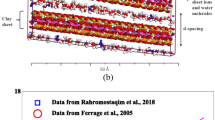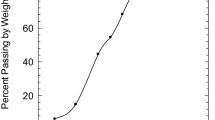Abstract
THE standard laboratory test method in soil mechanics for determination of the liquid limit of clays (upper plastic limit) depends on the facility of movement of particles relative to one another under conditions created by the test procedure. An interpretation of the upper plastic limit of clays has recently been suggested1 in terms of distance between particles or structural units of particles wherein forces of interaction become sufficiently weak to allow slipping to occur.
This is a preview of subscription content, access via your institution
Access options
Subscribe to this journal
Receive 51 print issues and online access
$199.00 per year
only $3.90 per issue
Buy this article
- Purchase on Springer Link
- Instant access to full article PDF
Prices may be subject to local taxes which are calculated during checkout
Similar content being viewed by others
References
Warkentin, B. P., Nature, 190, 287 (1961).
Mielenz, R. C., and King, M. E., Proc. First Nat. Conf. Clays and Clay Tech., California Bureau of Mines, Bull. 169, 218 (1955).
Warkentin, B. P., et al., Proc. Soil Sci. Soc. Amer., 21, 495 (1957).
Author information
Authors and Affiliations
Rights and permissions
About this article
Cite this article
YONG, R., SELIG, E. Role of Interparticle Forces in Development of Upper Plastic Limit of Clays. Nature 191, 938–939 (1961). https://doi.org/10.1038/191938a0
Issue Date:
DOI: https://doi.org/10.1038/191938a0
Comments
By submitting a comment you agree to abide by our Terms and Community Guidelines. If you find something abusive or that does not comply with our terms or guidelines please flag it as inappropriate.



